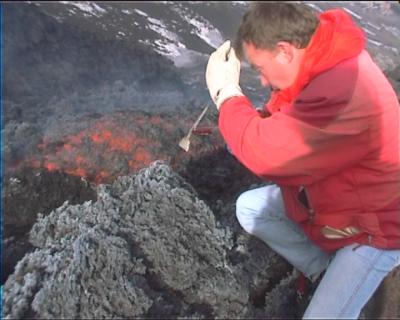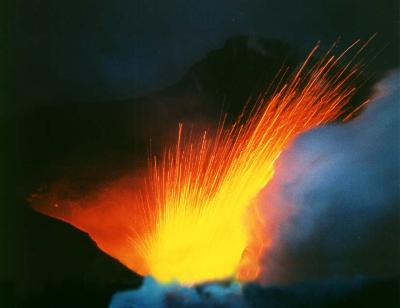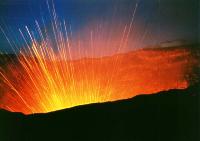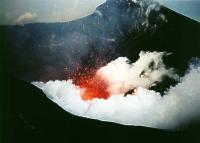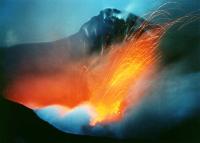|
WARNING:
Access to the summit area is again VERY
DANGEROUS. Explosive activity at the Bocca
Nuova is frequently ejecting bombs far beyond the crater rims,
most notably on its N, NW, W and SW sides. It is still officially
forbidden to go beyond 2700 m elevation on the S flank. Tourists
should make excursions only with the mountain guides, even though
this will not satisfy the wish to see what's going on at close
range. Besides this, weather conditions are often unstable.
Strong wind, snow or rain and clouds are occuring frequently
in the summit area, even during the summer, and one can get
easily lost. The mountain guides can be contacted at the cable
car (near the Rifugio Sapienza) on the southern side of Etna
(phone: 095-914141), or (during the summer) at the hotel "Le
Betulle" at Piano Provenzana, on the northern side (phone:
095-643430).
|
Do you look for books or videos about
volcanoes, volcanology, or in particular Mount Etna? Find and buy
them at Amazon.com!


These
ads help to keep this site alive. Click on them to give a small contribution
without paying anything (but for each click-through purchase made
through the first and last links the contribution will be larger!)
22 December 2000 update.
The show
at the SE Crater has not come. The small lava flow that had appeared
in late November on the NNE flank of the SE Crater cone persisted
through at least 2 December, and increased gas emission was noted
on 5 December. On this last occasion it seemed as though a new paroxysm
was imminent - but then things calmed down surprisingly. Since the
first week of December, also the Strombolian activity at the Bocca
Nuova subsided, and has been absent since, with a few isolated bursts
in mid December. Visitors to the craters in the past two weeks found
a state of absolute quiet.
On 17 December, a tourist from northern Italy attempted to reach the
summit area on his own, climbing up the NE flank from the Rifugio
Citelli during the afternoon. Weather conditions that day were unstable,
with clouds hovering over the mountain, and gale-force winds blowing.
The man lost track and had to seek shelter in a fracture of the 1928
eruption overnight, passing a traumatic night in freezing conditions,
while rescue teams were sent out in a first effort to find the man.
After an unsuccessful search on 17 December, a more massive effort
was made the following morning, and the man was finally found in a
slightly undercooled state, but in "generally stable conditions".
This was his first visit to Etna, and he had no knowledge of the mountain
and its peculiar microclimate. Once more it has been proved that no
one should try to climb Etna on his own, especially in the winter
season, and once more such an adventure has ended nearly fatally.
One year ago a skier lost his life on the W slope of the Valle del
Bove when he fell into an abyss.
On 21 December, fresh snow fell on Etna for the first time in a month,
but heat emitted from the main summit cone and the SE Crater cone
led to the rapid melting of much of the snow. It is likely that the
curent period of repose at Etna will not last long...
30 November 2000 update.
During
the past three months, the SE Crater has been one of the quietest
places on Etna. Some believed that the grand show - the dramatic series
of 66 (sixty-six) paroxysmal eruptive episodes - was definitely over.
On the other hand it was always clear that the crater would not remain
silent forever. Now it seems that the show will really go on: the
crater is reawakening from its three month-long slumber, and if it
maintains the style of activity shown earlier this year, it will finally
produce another paroxysm with lava fountains, lava flows and tephra
falls.
For many weeks, the only signs of activity at the SE Crater were a
few incandescent fumaroles in various locations on its cone and along
the eruptive fissure that extends from its summit down the NNE flank.
A particularly notable fumarole lay high on the SE flank of the cone,
another one in the central part of the NNE fissure. At dark these
fumaroles were distinctly glowing, probably because they discharged
very hot gas at temperatures of 800-900°C.
After a few days of bad weather, a clear increase in the intensity
of incancescence of fumaroles on the NNE fissure was noted on the
evening of 27 November by Giuseppe Scarpinati, who observed the volcano
from his home in Acireale, about 18 km SE of the summit. Using a special
light enhancing viewer, he was able to see a much larger incandescent
area along the fissure than previously; however, the glow was not
visible with the naked eye. The evening after, the glow had intensified
and was visible with a normal telescope. It was concentrated in the
central part of the NNE fissure, while another, smaller glowing spot
was discovered about 150 m further down the fissure, which displayed
an intermittent incandescence. Scarpinati was reluctant to speak of
a lava flow; he had seen many other lava flows at the same location
during their initial stages and remarked that each time the glow was
clearly visible with the naked eye.
On 30 November, Charles Rivière and others were able to reach
the area of the reported incandescence and received the clear confirmation
that extrusion of lava had started, forming a very small flow, which
was issuing from near a hornito formed during one of the latest eruptive
episodes in late August. Lava extrusion was accompanied by strong
degassing, but there was no explosive activity. Rivière photographed
and filmed the flow, and took samples of the fresh lava.
Eruptive activity was also observed at both vents in the Bocca Nuova.
During the past ten days these vents had been more or less continuously
active, but the activity had been very irregular and on 29 November
it had been particularly weak. On 30 November it was again much more
intense, but possibly not as vigorous as during October, when the
crater was frequently visited by Boris Behncke and others.
21 November 2000 update.
Italian
press sources report that a new burst of seismic activity has occurred
in the Etnean area on 19-21 November, this time affecting the NNW
flank of the volcano. As during the 5-6 November seismicity, the causes
of the earthquakes are probably related to tectonic movements along
faults lying below the volcanic edifice, not to the uprise of magma.
Some of the latest seismicity was felt in Randazzo, but no damage
was reported.
At the Bocca Nuova, mild eruptive activity has continued without significant
changes; sometime during the past week a weak incandescence was noted
at the NE Crater by Giuseppe Scarpinati (the incandescence could be
seen only with the aid of a night viewing device). There has been
a slight increase in the intensity of incandescence in a few spots
high on the SE side of the SE Crater cone. The current situation is
fairly normal, quite different from the highly elevated levels of
activity during the past 2.5 years.
12 November 2000 update.
Mild Strombolian
activity has continued during the past week at the Bocca Nuova; the
levels of activity appeared generally lower than during the week before.
There is no evidence of any effusive activity, and it seems that the
two active pits in the Bocca Nuova have not yet been filled to their
rims. Occasional episodes of stronger activity have thrown incandescent
pyroclastics over the SW rim of the Bocca Nuova, and the area has
to be considered highly dangerous to visitors.
Aftershocks of the 5 November tectonic earthquake on the S flank (see
previous update below) continued until shortly after 0900 h on the
next day, with a total of 119 shocks (quoted from the 7 October issue
of "La Sicilia").
No other significant events have been noted throughout the week.
6 November 2000 update.
The following information is based on local press reports (mainly
"La Sicilia", 6 November
2000 issue), which cite scientists of the Poseidon
monitoring network. A fairly high level of accuracy should therefore
be granted.
A large area of eastern Sicily was shaken by a moderate earthquake
on the late afternoon of 5 November (1826 h local time). The magnitude
of the shock was 3.6, and it was felt in the provinces of Catania,
Siracusa, Ragusa and Messina. Interestingly the epicenter was located
near Monte Vetore, a prehistoric pyroclastic cone at about 1820 m
elevation on the S flank of Etna. The focal depth was given as 10
km, and Poseidon scientists cited in the press reports interpreted
it as a purely tectonic earthquake, not related to the movement of
magma. This interpretation is supported by the fact that the earthquake
was felt over such a large area.
The first and strongest shock was followed, within the next two hours,
by sixty minor tremors. Damage was limited to "a few broken plates",
and numerous anxious residents called the police or other emergency
centers.
At the same time eruptive activity is going on at the Bocca Nuova,
and as before there are strong fluctuations in the level of activity.
Late on 3 November, Marco Fulle, Tom Pfeiffer and others were able
to reach the rim of the Bocca Nuova and observe eruptive activity,
which was at that time confined to the E vent, whereas the NW vent
was fairly quiet.
On 5 November, visitors at Rifugio Citelli and elsewhere on the mountain
heard loud detonations from the summit area, but low clouds prevented
them from viewing the upper part of the volcano. The press report
in "La Sicilia" states that on 5 November there was some
effusive activity at the Bocca Nuova, but "the lava flow remains
confined to the summit area".
It can be expected that the forthcoming weekly
report of the Poseidon monitoring network will give more precise
details of the events in the past few days.
|
Activity
at the Bocca Nuova,
25 October 2000
Photos
by Thorsten Boeckel
|
|
|
|
Explosion
at the E vent of the Bocca Nuova, photographed at nightfall
from the S rim of the crater. Explosions like the one shown
here ejected bombs beyond the crater rim, and Boeckel, the author
of this photo, left that observation place just in time before
stronger explosions sent bombs far beyond that place.
|
|
|
|
|
Explosive
activity at the NW vent (top left) and at the E vent (photos
at right), photographed from the S rim of the Bocca Nuova at
around sunset on 25 October
|
|
2 November 2000 update.
The eruptive activity at the Bocca Nuova has continued with fluctuations,
as during the previous weeks. On the evening of 30 October, Giuseppe
Scarpinati observed intense, continuous explosive activity at both
vents (NW and E vents) that was visible with the naked eye from his
home in Acireale. Incandescence was also visible on the upper SE flank
of the SE Crater cone, and a dull, fluctuating glow could be observed
at the NE Crater.
On the morning of 31 October, strong explosive activity continued
at the Bocca Nuova, forming a dense plume of gas mixed with some ash.
On 2 November, Marco Fulle (Stromboli On-line), Tom Pfeiffer (University
of Arhus, Denmark) and others attempted a climb to the Bocca Nuova
but had to return about 100 m from the SW rim of the crater, because
almost incessant explosions threw bombs over the crater rim. The explosions
almost certainly came from a source in the E part of the crater, not
the NW vent, which was only strongly degassing.
Several
other web pages covering the recent and ongoing eruptions of the Southeast
Crater are now available; these contain photos and movie clips of
some of the most spectacular moments of that period.
Etna
in 2000 - a list of all paroxysms at the SE Crater since 26 January
and photos (this site)
Etna
in 2000 - various pages at Stromboli On-line with photos and movie
clips of SE Crater paroxysms and Bocca Nuova gas rings: most photos
are of Marco Fulle, the artist photographer among us
Extremely
spectacular video clips, taken by British cameraman and film maker
David Bryant on 15 February 2000
At
"Italy's Volcanoes" -
At Stromboli On-line
An
interview with Boris Behncke, made in late February 2000 by a BBC
team
and a video
clip (RealPlayer)
Photos
of the eruptive activity, 15-23 February 2000, by Tom Pfeiffer (University
of Arhus, Denmark) - scroll to bottom of page
Photos
of an eruptive episode on 13 February 2000, posted on the web site
of the Association Volcanologique Européenne, Paris, France
Thorsten
Boeckel's web site (Germany) with photos and movie clips of several
paroxysm of the SE Crater in February, April and June 2000
A
small web page reporting on Etna's current activity - and check what
happens to your cursor on that page...
Charles
Rivière's Etna home page, with many photos and video clips
(the most recent of the paroxysm of 5 May 2000), frequent updates,
and other, highly interesting items (in French and English)

